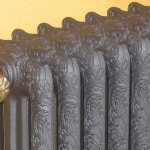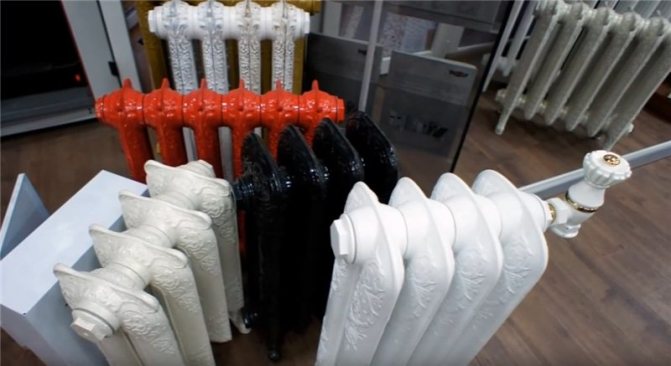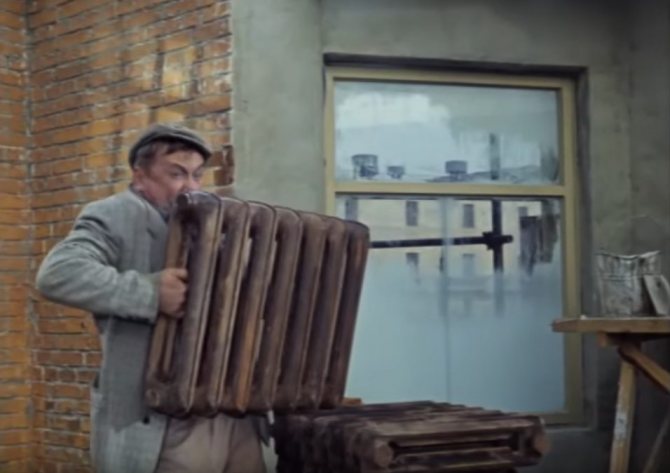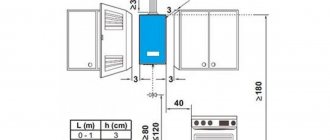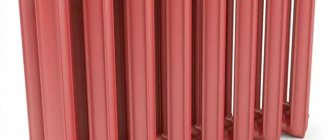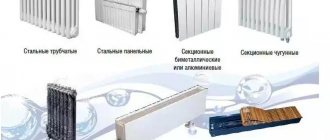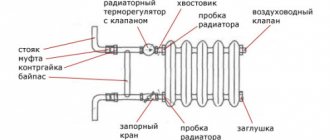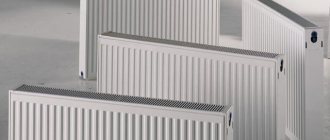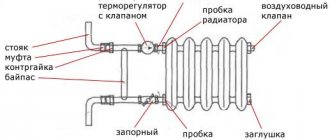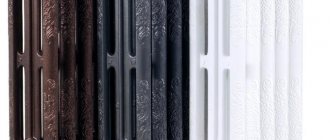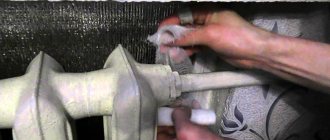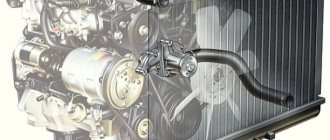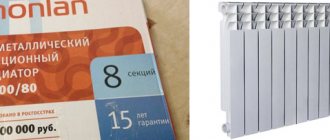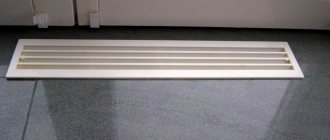Despite the creation of a huge number of new generation heating batteries from various modern materials, cast iron batteries are still able to compete with new models.
To find out how much one section of a cast-iron battery weighs, you need to pay attention to the manufacturer of heating radiators.
Everything new is well forgotten old
What does the weight of the battery matter
It is necessary to have information on how much a cast-iron heating radiator weighs for a number of reasons. For example, if batteries are purchased for installation in an entire private household, it is required to calculate the carrying capacity of a machine transporting heating devices, and you should also decide on the number of movers who will bring them into the house.
For clarity, you can compare the weight of cast-iron radiators of outdated samples and modern analogues made of other materials:
- one section of standard batteries made of cast iron with an inter-axle distance of 500 mm weighs 5.5 - 7.2 kilograms, and with an inter-axle parameter of 300 mm - from 4.0 to 5.4 kilograms;
- the weight of the rib of non-standard cast-iron heating devices ranges from 3.7 to 14.5 kilograms;
- the section of the aluminum battery weighs 1.45 kilograms with an center gap of 500 millimeters, and 1.2 kilograms at 350 millimeters;
- bimetallic devices with a center distance equal to 500 mm weigh 1.92 kg / section, and at 350 mm, 1.36 kg / section.
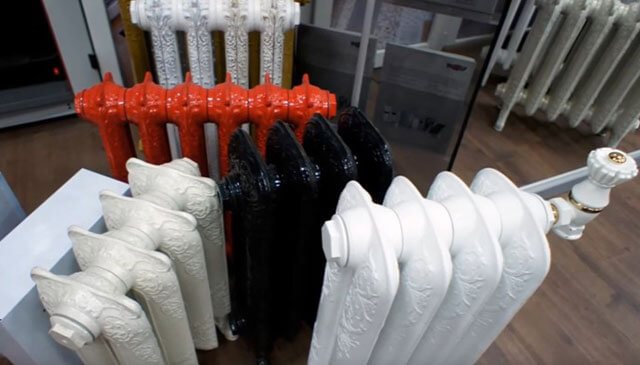
When carrying out repairs and replacement of heating equipment in a house, it is important for its owners to know how much the old cast-iron battery weighs in order to decide whether it will be possible to independently take out the old multi-section radiator to the street, since it is necessary to calculate their own strength. But there is no such data.
The reason is that there are different models in operation. Moreover, they have the same purpose, but different weight. In addition, devices that differ in size and variety of shapes are sold on the domestic market.
Today, for example, there are more than several dozen names of traditional cast iron batteries, and it is difficult to count models made in a designer style. At the same time, such a parameter as the weight of one section of a cast-iron radiator is very different.
The advantages of cast iron
Cast iron batteries are the most profitable heating devices. If you do not take into account how much one edge of a cast-iron battery weighs, then you can safely select a whole range positive qualities of cast iron:
- high heat transfer;
- reliability;
- strength;
- firmness;
- durability;
- the period of operation is more than 50 years.
The appearance of typical cast-iron radiators is usually uncomplicated. But nowadays there are a lot of heating devices made in the form of old products.
The advantage of such forms is the elegance and decency of their appearance.
Weight of standard heaters
Both traditional and designer pieces are united by the material of manufacture, which is cast iron.
And now everywhere there are regularly serving classic accordion-shaped radiators, installed:
- in schools and preschool educational institutions;
- in outpatient departments and hospitals;
- in the premises of the housing stock - apartments, private households, hostels;
- in public and state institutions.
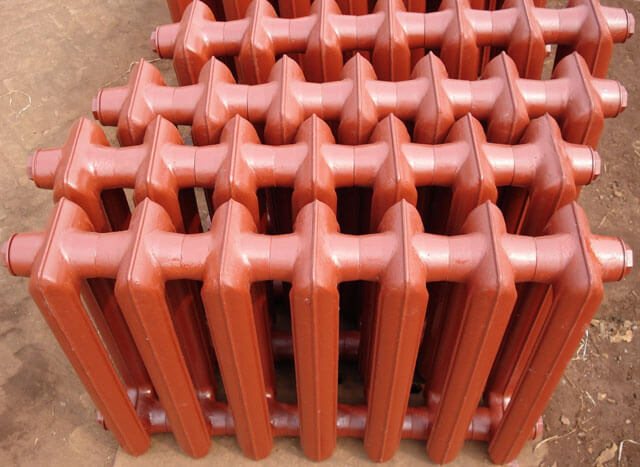

Usually these are models MS-140 or MS-90, since in past years there were no other mass-produced heating devices. Cast iron products NM-150, RKSH, Minsk-1110 and others are presented in small series, but today they are no longer produced.So what is the weight of one section of an old-style cast iron battery? And in this case, there is no exact figure. This is explained by the fact that this value depends on the parameters of the section.
For example, a battery of the MC-140 series can be of two modifications, depending on the center distance, which is 300 or 500 millimeters. If we are talking about the MC-140-300 model, then the average weight of the section is about 5.7 kilograms, and when about the MC-140-500 device, then 7.1 kilograms.
You can often find a product of the MC-90 series, in which the weight of a cast-iron radiator section is 6.5 kilograms with a distance between the axes of 500 millimeters. The difference between the MC-90 and 140 models lies in the different depths of the sections.
Can we assume that the weight of the radiators of these popular series, equal to 6.5, 5.7 and 7.1 kilograms, is final? The answer is no, and there is an explanation for this. The fact is that the current GOST 8690-94, which is a regulatory document regulating the production of batteries from cast iron alloys, indicates their main dimensions.
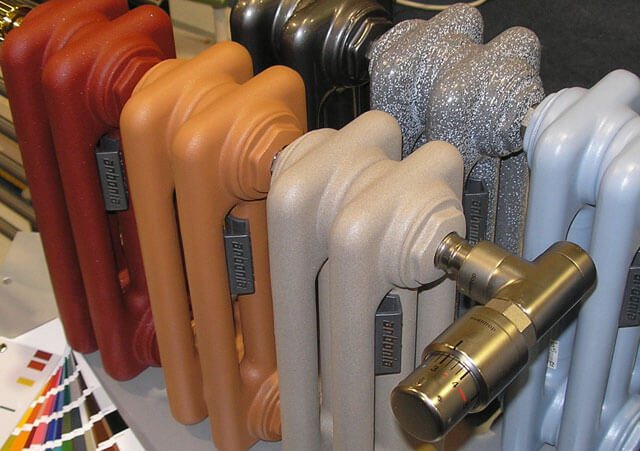

Regarding how much the section of the old-style cast-iron battery weighs, this standard indicates the specific gravity - 49.5 kg / kW. This standard value applies to radiators that are intended for operation in heating systems with a coolant temperature not exceeding 150 degrees at an excess operating pressure of a maximum of 0.9 MPa (9 kgf / cm²).
In the production of heating devices, manufacturers must ensure that the products comply with these values, but GOST does not regulate how much one section of the cast-iron battery weighs. As a result, the mass of radiators manufactured in different factories is different.
Today, the most famous are the products of several industrial enterprises that produce modifications of the MC-140 series and devices of their own design. Among them: the Belarusian plant of heating equipment, the Russian "Descartes" and "Santekhlit" and others.
Dimensions of one section
The weight of one section of an old-style Soviet-made cast-iron battery is almost seven kilograms, in contrast to the Czech model, one section of which weighs about four to five kilograms. Batteries MC - 140 are the most relevant and most often used for heating large rooms.
In this video, we will consider the prices for cast iron batteries:
Dimensions of one section:
- distance between axles - 19.69 inches (500 mm);
- height - 23.15 inches (588 mm);
- depth - 5.51 inches (140 mm);
- length - 4.25 inches (108 mm);
- thread diameter - 1 inch and a quarter;
- weight - 14.77 lbs (6.7 kg);
- water capacity ≈ 1.5 l;
- nominal heat gain at ΔТ 70 0 C - 160 W;
- working pressure - up to 9 Atm.
Such devices are manufactured in Minsk and Lugansk from cast iron raw materials. MS - 90 batteries are produced in Russia and are also very popular among the population.
Technical characteristics of MS - 90:
- thermal power - 130 W;
- the clearance of one rib is almost 90 mm;
- height - 600 mm;
- depth - 100 mm;
- volume - 1.5 l;
- axial distance - 550-600 mm;
- heating degree - 125 0 C;
- working pressure value - 9-12 Atm.
They are intended for both production and living rooms. The batteries are assembled into a single whole using clamps and rubber seals. The differences between the devices from each other are only in the color scheme: the Minsk ones are red, and the Luhansk ones are gray.
Russian and foreign manufacturers additionally coat the surface of their heating systems with anti-corrosion spraying, so they have a higher resistance to destruction and a more glossy surface, which reduces hydraulic resistance.
Weight of a section of cast iron radiators from different manufacturers
To figure out how much a section of a cast-iron battery from different companies weighs, you need to familiarize yourself with the assortment they produce:
- Nizhniy Tagil boiler and radiator plant... This manufacturer provides a passport for each of its products, which indicates the number of sections. The company offers 4 cast iron models. At the same time, the exact weight of the section is: for MS-140-M-300 radiators - 5.4 kilograms; MS-140-M2-500 - 6.65 kilograms, MS-90 and T-90 M, respectively 5.475 and 4.575 kilograms.
- Belarusian "Bas-relief"... It produces mainly single-channel sectional radiators, made in a modern design. This manufacturer manufactures 9 models of cast iron batteries, in which the exact weight of the rib ranges from 3.7 kilograms (2K60P-300 products) to 6.7 (MS-140M).
- Russian "Santekhlit"... The company has now been shut down, but its products are still sold in the trade network. The exact weight of the edge of the batteries ranges from 4.45 kilograms (MC-85 and MC-110-300 models) to 7.1 kilograms (MC-140M).
Dimensions of one section
The weight of one section of an old-style Soviet-made cast-iron battery is almost seven kilograms, in contrast to the Czech model, one section of which weighs about four to five kilograms. Batteries MC - 140 are the most relevant and most often used for heating large rooms.
In this video, we will consider the prices for cast iron batteries:
Dimensions of one section:
- distance between axles - 19.69 inches (500 mm);
- height - 23.15 inches (588 mm);
- depth - 5.51 inches (140 mm);
- length - 4.25 inches (108 mm);
- thread diameter - 1 inch and a quarter;
- weight - 14.77 lbs (6.7 kg);
- water capacity ≈ 1.5 l;
- nominal heat gain at ΔТ 70 0 C - 160 W;
- working pressure - up to 9 Atm.
Such devices are manufactured in Minsk and Lugansk from cast iron raw materials. MS - 90 batteries are produced in Russia and are also very popular among the population.
Technical characteristics of MS - 90:
- thermal power - 130 W;
- the clearance of one rib is almost 90 mm;
- height - 600 mm;
- depth - 100 mm;
- volume - 1.5 l;
- axial distance - 550-600 mm;
- heating degree - 125 0 C;
- working pressure value - 9-12 Atm.
They are intended for both production and living rooms. The batteries are assembled into a single whole using clamps and rubber seals. The differences between the devices from each other are only in the color scheme: the Minsk ones are red, and the Luhansk ones are gray.
Russian and foreign manufacturers additionally coat the surface of their heating systems with anti-corrosion spraying, so they have a higher resistance to destruction and a more glossy surface, which reduces hydraulic resistance.
How much does a custom cast iron battery weigh
Now it became clear what the weight of the cast-iron battery of the series common among consumers is. But the characteristics of non-standard devices differ in terms of cost and weight.
For example, one section of a French-made Guratec Apollo 795 three-channel floor-standing radiator weighs 13.5 kilograms. The product is presented for sale with 7-section batteries, the total weight of which is 94.5 kilograms. During its transportation, unloading and installation, the help of several workers is required.
The Czech manufacturer Viadrus produces more affordable products. The weight of the radiator section made of cast iron alloy Kalor 500 × 160 is 5.6 kilograms.
Before being sold on domestic markets, foreign heating devices must undergo a mandatory certification procedure for compliance with GOST standards, but the weight of the section is not taken into account.
The advantages of cast iron
Cast iron batteries are the most profitable heating devices. If you do not take into account how much one edge of a cast-iron battery weighs, then you can safely select a whole range positive qualities of cast iron:
- high heat transfer;
- reliability;
- strength;
- firmness;
- durability;
- the period of operation is more than 50 years.
The appearance of typical cast-iron radiators is usually uncomplicated.But nowadays there are a lot of heating devices made in the form of old products.
The advantage of such forms is the elegance and decency of their appearance.
Basic characteristics of a classic radiator
A standard cast iron battery consists of 4-10 individual sections. Its size depends on the choice of thermal conditions in the room and the architectural features of the house.
Despite the difficulties that arise when installing a heavy cast iron heating radiator, this is not considered the main problem. The main task is to carry out the correct installation of the battery. To implement it, it is not enough to know only the mass of the product, it is necessary consider the following points:
- Distance between axles. Standard models can be 350 or 500 mm. Batteries with high heights are characterized by proportional dimensions between the axles.
- Depth. Standard sizes 92, 99, 110 mm.
- Section width. The sizes are in a slightly larger range - 35 - 60 mm.
- Section volume. This is the amount of coolant that is required to completely fill the radiator element. The volume depends on the size of the section. Average values range from 1 to 4 liters.
An important problem with installing a classic cast iron battery is that it is only intended for wall mounting. At the same time, most modern houses made of porous materials, such as aerated concrete, foam concrete, as well as SIP panels with foam filling. These walls require a special fastening of a complex structure with multi-point fixation, which is unlikely to be to your liking.

